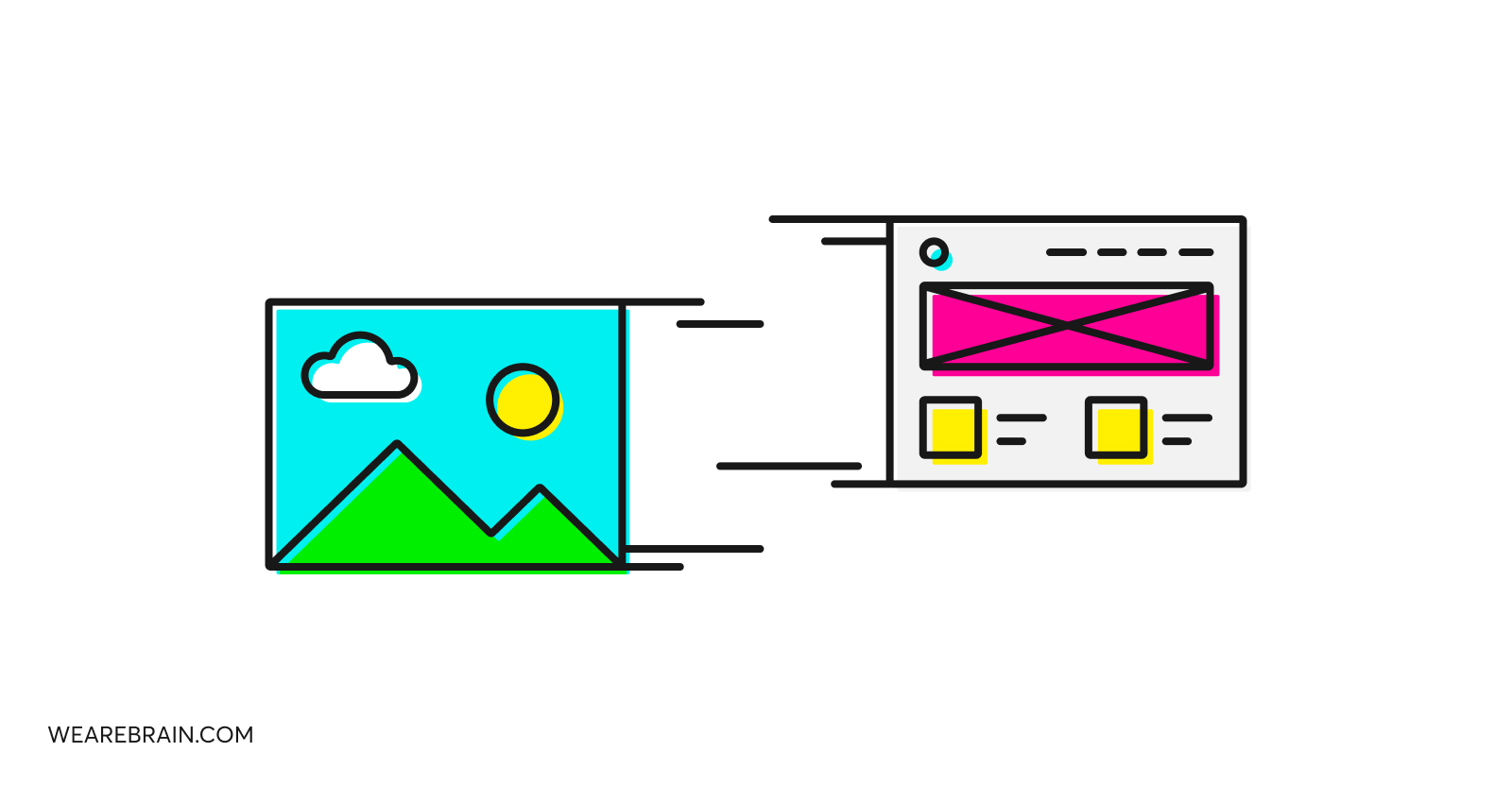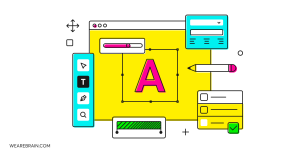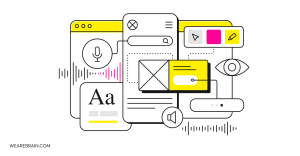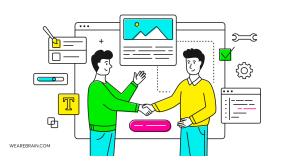How to transition from graphic design to UX design

If you are a graphic designer looking to pursue a career pivot into user experience (UX) design then you have come to the right place.
There may be a multitude of reasons why you are looking for a career change into UX design. Maybe you are considering the change because you have a desire to see ‘under the hood’ of your surface-level design work, and are keen to further explore the digital architecture and psychology involved in UX design. But let’s face it: the most common reason is money. According to Payscale, UX designers in the USA earn up to 40% more on average than graphic designers. That’s a large enough percentage to get even the most passionate graphic designers to take notice. Whatever your reasoning, your friends at WeAreBrain have laid out a simple path of how to transition from graphic design to UX design.
The process
Most commonly, graphic designers do not jump directly into UX design without focusing on visual/user interface (UI) design as a precursor. UI designers create visually appealing layouts for digital applications, such as websites, mobile apps, desktop apps, etc. Although UI design is pixel-focused, it leans more toward UX as it designs with the user experience in mind.
Understanding the differences and similarities
- Graphic design: deals primarily with the aesthetic design of traditional elements, such as colours, imagery, and typography of brochures, posters, corporate reports, etc.
- UI design: deals primarily with the aesthetic design of the interface, such as colours, imagery, and typography, but for digital applications such as websites, mobile apps, etc.
- UX design: deals with perfecting the product architecture by understanding user needs. This is achieved by studying various user groups, understanding and exploring user journeys, and conducting interviews and test groups to best understand the needs of users in order to provide solutions. Once the user architecture is developed, graphic designers are called in to provide visually stunning aesthetics to the product.
Graphic design involves developing the overall design layout for various applications, mainly digital elements, magazines, advertisements, business reports, etc. Thus, graphic designers need to have a good eye for design and execution. Typography, colours, and all various visual components are the tools graphic designers use to create stunning looking concepts. Graphic design produces standalone elements, meaning the end result remains the same, with designers having complete control over how designs are viewed.
UI design, on the other hand, is always part of a system. It is interactive and thus subject to change according to the direction of the project. UI designers have no control over how their designs are viewed as their work is displayed across many screens of various sizes, aspect ratios, colour contrast ratios, etc. UI design focuses on the visual layout and design elements of digital products.
UX design is different. It focuses on the entire process of product integration, including elements of branding, design, usability, and functionality. It is a common misconception that UX designers are required to be skilled at visual/graphic design and coding. While these will certainly help in making any potential UX designer transition from good to great in a shorter period of time, they are not entirely necessary. What good UX designers fundamentally need to possess is sharp analytical skills, problem-solving capabilities, and empathy.
Both graphic design and UX design deal with emotional design, creative thinking, and prototyping, but graphic design is pixel-focused while UX design is user-focused. Graphic design aims to create amazing aesthetics, whereas UX design aims to predict and solve the user’s problems while creating a pleasant interactive experience.
Core competencies and transferable knowledge
Thankfully the transition from graphic design to UX design doesn’t require you to forget everything to start fresh, as many skills and competencies can be carried over.
The UX design process
A typical UX design process involves many elements of design thinking, and so is not a drastic step away from graphic design and UI design, it just involves more steps, analysis, and testing. These steps generally follow these design thinking principles:
- Research: know and understand users
- Analyse: identify user needs to provide solutions
- Design: create general ideas for the overall design approach
- Prototype: transform these general ideas into specific elements and examples
- User testing: evaluate the efficacy of the design
Specialisation vs Multidisciplinary
In today’s professional career climate, the debate rages on whether being a specialist or a multi-disciplinarian either helps or hinders your prospects of employability. On one hand, some suggest that specialising in a particular career will help you stand out from the competition, and afford you to charge higher rates because you are better than most at one particular job, and are thus considered ‘rare’. While others are of the idea that being good at many things is better than being great at only one. Some say it improves the likelihood of employability and overall relevance in a working environment. Both have merits, both have downsides.
Graphic design is a specialised art which involves artisanship according to a particular set of specialised skills used in creating beautiful aesthetics. Commonly, you either ‘have it’ or you don’t. UX design is a tactical ‘Jack-of-all-trades’ of the digital design world as it requires many disciplines and various knowledge. Human psychology, interaction design, information architecture and user research techniques are all required for good UX design to solve user needs and requirements. Of course, UX designers should have a good idea of graphic design and overall design thinking, but their focus goes beyond surface aesthetics and deeper into investigating how users will interact with the overall platform.
So, if you are serious about transitioning from graphic design to UI design to eventually UX design, there are many requirements you need to meet other than having strong design abilities.
Why should you switch from graphic design to UX design?
As mentioned above, UX designers earn considerably more than graphic designers. This is usually enough for most people, but if money isn’t your sole driving force then there are other compelling reasons to make the switch.
If you are interested in the problem-solving space of design and want to understand more about the reasons behind why and how people interact with digital products, then UX design is for you. The work is substantially more involved, engaging, and rewarding. It is challenging due to so many variables to consider that you will never get bored, only more motivated. The digital industry is continuously booming and so UX designers are in high demand, with not enough skilled people out there, so now is the time to start! Digital is also not going anywhere, in fact, it is becoming more pervasive: this means there will always be work across a variety of different industries. It is also very sociable as it involves in-person interaction with many people, so if dealing with humans is something you enjoy then you will get to do a lot of it if you choose to become a UX designer.
Summary
As you can see, although the transition from graphic design to UX design doesn’t require a complete overhaul of skills, it does necessitate further upskilling. Having a good handle of aesthetic design is already a major feather in your bow: all that is required is to take a deep dive into the world of UX to see how your skills can be transferable. There are many online UX design courses to choose from, from basics to proficiency. By immersing yourself in UX design you will be able to better understand how your graphic design skills can bolster your offering to the UX space.
Anastasia Gritsenko
Working Machines
An executive’s guide to AI and Intelligent Automation. Working Machines takes a look at how the renewed vigour for the development of Artificial Intelligence and Intelligent Automation technology has begun to change how businesses operate.







